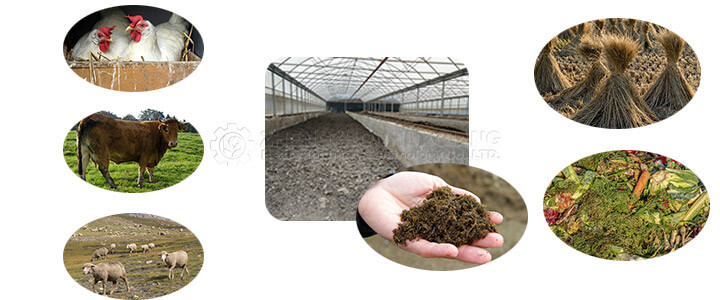The transportation distance of raw materials for organic fertilizer production in fertilizer plant is generally no more than 100km.There are many ingredients suitable for composting, and different categories can be divided into different types.
a)Composting main material. The main material is the main raw material for composting production, which usually accounts for 30% - 80% of the material proportion. Mainly composed of one or several raw materials, commonly used are animal manure, peat sludge and so on.
b)Composting accessories. Supplementary materials are mainly used to adjust the moisture content, carbon-nitrogen ratio, acid-base value, permeability of some raw materials, consisting of one or several raw materials. Usually, the proportion of such raw materials in the whole material does not exceed 40%, and the proportion of single material does not exceed 20%. Commonly used auxiliary materials are straw powder, rice husk powder, rice chaff, wheat bran, cake, mushroom residue, fly ash, quicklime, superphosphate and phosphate rock powder.
In the organic fertilizer production, according to the nature of raw materials, composting materials can be divided into carbon raw materials, nitrogen raw materials and conditioner raw materials.
a)Composting carbon raw materials. Refers to those raw materials with high organic carbon content, which can be used as the main composting materials, such as straw in the straw composting, but most of them are used as supplementary materials to regulate moisture, carbon and nitrogen ratio and enhance the permeability of materials, such as straw powder, rice husk powder, rice chaff, peat, fly ash, etc.
b)Nitrogen raw materials for composting. Usually refers to those raw materials whose carbon and nitrogen values are below 30%. These raw materials can be used as composting materials, such as livestock manure, sugarcane sludge, etc. There are also some high nitrogen raw materials used as supplementary materials to regulate carbon and nitrogen, such as fish meal, meat and bone meal, urea and so on.
c)Compost conditioner and expansive agent. It mainly refers to the properties of raw material mixtures, such as acid-base value, water content, texture, carbon-nitrogen ratio, aeration and so on, which are added to compost.
